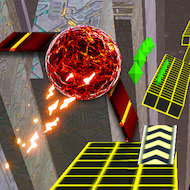
Bumpy Jumpy
Bumpy Jumpy throws players into a vertical gauntlet where climbing is constant, but safety is temporary. The bouncing never stops, and your task is to guide a perpetually jumping character onto increasingly unstable and deceptive platforms. With every meter you gain, the environment throws more obstacles, faster movement, and trickier physics at you, demanding sharper reaction times and cleaner movement paths. It’s a test of how well you adapt under rising pressure.
Learning the Bounce-Based Gameplay
At the heart of Bumpy Jumpy is its continuous jump mechanic. You’re not pressing a jump button — the character bounces automatically. You only steer left or right. This means your success depends on spatial judgment and real-time prediction rather than reaction-based platforming. Every platform behaves differently depending on its material, shape, and position. As you ascend, more platform variants are introduced, including ones that spin, vanish, or attempt to trick your landing judgment with false visuals.
- Core gameplay revolves around managing side-to-side movement during each bounce cycle.
- No direct jump input creates a fixed rhythm the player must work within.
- Early jumps are forgiving, but difficulty ramps quickly with platform complexity.
Hazards, Traps, and Platform Psychology
Unlike static platformers, Bumpy Jumpy focuses heavily on environmental unpredictability. Spikes appear at irregular intervals. Certain platforms will shimmer to suggest they’re real but vanish the moment you commit. Others shift horizontally or fall away when touched. The visual design often forces players to make assumptions — which means the better you observe, the more you survive. Every hazard demands you learn from past failures and refine your decision-making. Memorizing patterns can help, but the game relies on your ability to adapt to real-time threats and recover from close calls.
- Fake platforms are designed to blend in with real ones but fade instantly under pressure.
- Spikes are not just on platforms — they also emerge from walls and ceilings.
- Falling ledges often seem solid until weight causes immediate drop.
Climbing Efficiency and Bounce Optimization
There’s no score counter in the traditional sense — instead, your progress is tied directly to your climb height. The game records how far you get and resets upon failure. Advanced players will learn to “read” the movement of platforms, predicting their motion before even landing. It becomes critical to think several jumps ahead, analyzing where to go after the current platform. Optimizing each bounce includes avoiding risky paths, using edge landings for emergency corrections, and treating the screen’s upper third as an active threat zone due to low visibility.
- Stick to the middle of each platform when unsure of its stability.
- Watch two bounces ahead to keep a consistent and prepared trajectory.
- Don’t chase high scores — climb rhythmically, not recklessly.
Bumpy Jumpy is more than a reflex challenge — it’s a behavioral loop of error and improvement. Each time you fall, you return more experienced, and slowly, patterns emerge from the chaos. The game builds tension by design, combining predictable movement with randomized risks. Only players who learn to slow their minds, sharpen their instincts, and commit to disciplined play will find themselves reaching the upper heights. One wrong bounce may end the run, but every successful jump is a step closer to mastery.
Comments
There are no reviews yet. Be the first one to write one.



































